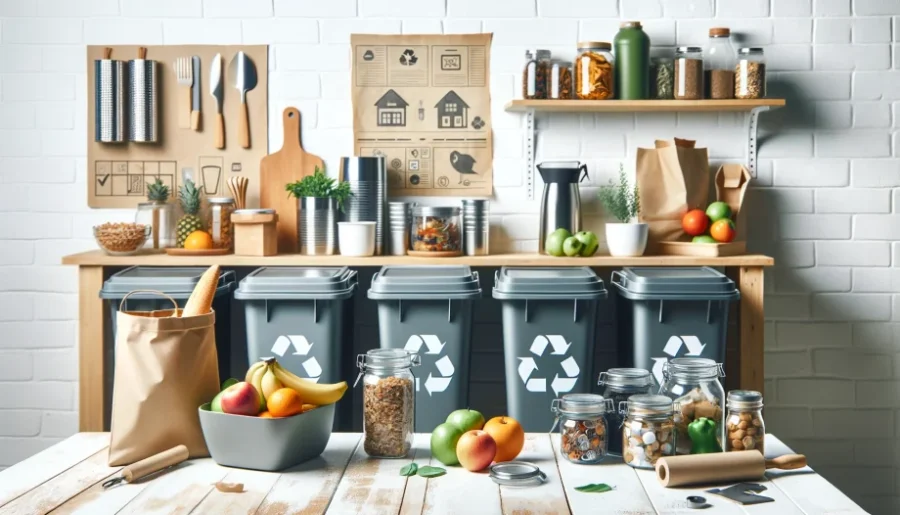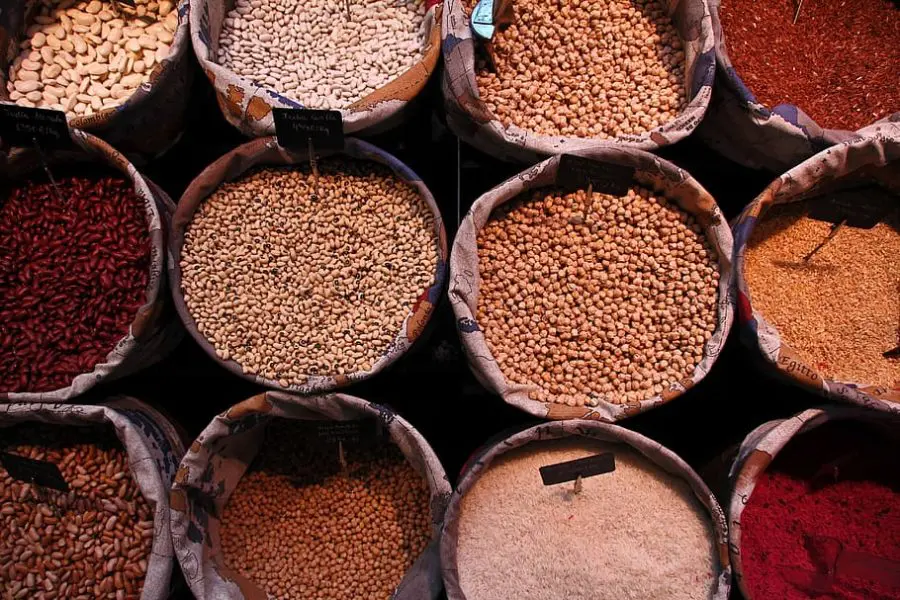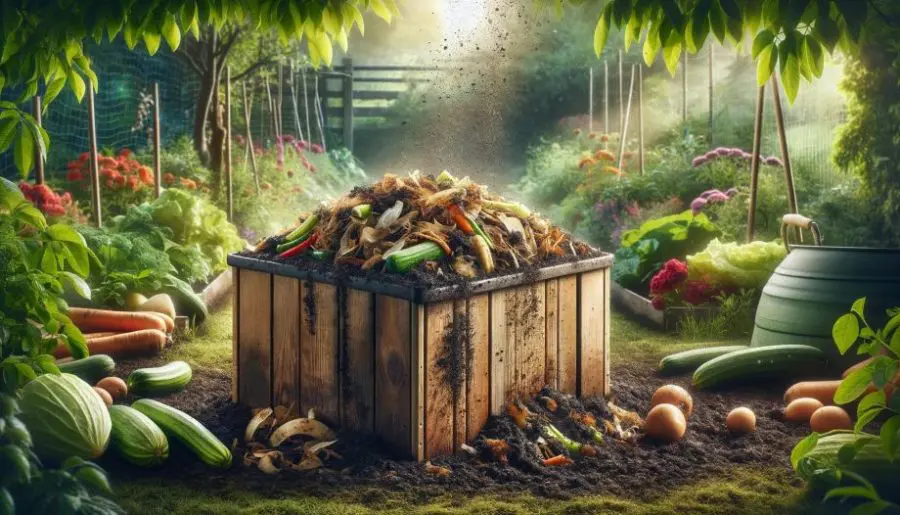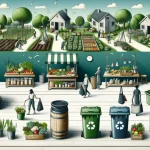
Discover the power of minimizing food waste with our practical tips. Save money, reduce your environmental impact, and enjoy delicious meals with less waste!
Minimizing Food Waste Key Takeaways:
Minimizing food waste is a journey that starts in our kitchens and impacts the entire planet.
By making small changes in how we shop, cook, and store food, we can reduce waste, save money, and contribute to a healthier environment.
Join us as we explore simple yet effective ways to minimize food waste and make a positive difference.
Introduction: The Importance of Minimizing Food Waste
A Global Challenge
Minimizing food waste is crucial for both environmental and economic reasons.
Globally, about one-third of all food produced is wasted, leading to significant carbon emissions, water wastage, and land use.
Environmental Impact
Reducing food waste can help combat climate change, conserve resources, and save money.
It also addresses food insecurity by redirecting surplus food to those in need.
Promoting Sustainability
By making conscious choices in how we purchase, store, and use food, we can reduce waste, promote sustainability, and create a more equitable food system.
This collective effort can lead to a profound positive impact on our planet and society.
For more information on the importance of minimizing food waste, visit the U.S. Food and Drug Administration, the Food and Agriculture Organization of the United Nations, and the U.S. Environmental Protection Agency.
Things to Know: Understanding Food Waste

The Global Picture
Food waste is a pressing issue worldwide, with approximately one-third of all food produced going to waste.
This equates to about 1.3 billion tons of food annually.
The problem is prevalent in both developed and developing countries, though the reasons for waste differ.
Economic and Environmental Consequences
The economic cost of food waste is staggering, amounting to billions of dollars each year.
Environmentally, food waste contributes to greenhouse gas emissions, with discarded food rotting in landfills and releasing methane, a potent greenhouse gas.
It also represents a wasteful use of resources, including water, land, and energy, used in the production, transportation, and storage of food.
Social Implications
Food waste also has social implications, particularly when considering that millions of people around the world face food insecurity.
The food that is wasted could potentially feed those in need, highlighting the importance of redistributing surplus food and improving food systems.
Moving Forward
Addressing food waste requires a multi-faceted approach, including improving supply chain efficiency, enhancing food storage and preservation methods, changing consumer behavior, and implementing policies that promote sustainable food practices.
For a deeper understanding of the current state of food waste globally and its impacts, you can refer to resources from the Food and Agriculture Organization of the United Nations and the World Wildlife Fund.
Reduction: How to Reduce Food Waste?

Planning and Shopping Tips
To avoid buying excess food, planning and smart shopping are key. Start by making a meal plan for the week, considering what you already have in your pantry and refrigerator.
Create a shopping list based on your meal plan and stick to it when grocery shopping.
Avoid impulse buys and be cautious of bulk deals that may lead to more food than you can consume.
Consider using shopping list apps to keep track of what you need.
Cooking Smarter
When cooking, prepare the right quantities to avoid leftovers that might go to waste.
If you do have leftovers, store them properly in airtight containers and label them with the date.
Use leftovers as ingredients for new meals or repurpose them creatively.
For example, stale bread can be turned into croutons, and overripe fruits can be used in smoothies or baking.
Storing Leftovers Properly
Proper storage of leftovers is crucial to extend their freshness, maintain food safety and prevent waste.
Use clear containers so you can easily see what’s inside, and keep your refrigerator organized to avoid forgetting about stored food.
Regularly check your fridge and pantry to use up items that are nearing their expiration date.
For more tips on reducing food waste through planning, shopping, and cooking, visit the U.S. Food and Drug Administration and Save The Food.
Overview: What is Reducing Food Waste?

Definition
Reducing food waste refers to the actions and strategies aimed at minimizing the amount of food that is discarded or left unused.
It encompasses a wide range of practices, from better food planning and storage to more efficient cooking methods and creative reuse of leftovers.
Food loss and waste
Food loss and waste is food that is not eaten. The causes of food waste or loss are numerous and occur throughout the food system, during production, processing, distribution, retail and food service sales, and consumption. Overall, about one-third of the world’s food is thrown away. Wikipedia
Explanation
The goal of reducing food waste is to ensure that as much food as possible is consumed or used effectively, rather than being thrown away.
This involves being mindful of food purchases, storing food correctly to extend its shelf life, and finding innovative ways to use up food that might otherwise go to waste.
Reducing food waste not only helps in saving money and resources but also has significant environmental benefits by decreasing the amount of waste sent to landfills and reducing greenhouse gas emissions.
For a more detailed explanation of reducing food waste and its importance, you can visit resources like the Environmental Protection Agency and the Natural Resources Defense Council.
Importance: Why is it Important to Reduce Food Waste?

Environmental Benefits
Reducing food waste has significant environmental benefits. It helps conserve resources such as water, land, and energy used in food production.
It also reduces greenhouse gas emissions associated with food production and disposal.
When food waste decomposes in landfills, it releases methane, a potent greenhouse gas.
By reducing food waste, we can decrease the amount of methane emissions and help combat climate change.
Economic Benefits
From an economic perspective, reducing food waste saves money for households, businesses, and governments.
It reduces the cost of purchasing, processing, and disposing of food. For consumers, minimizing food waste means lower grocery store bills.
For businesses, it can lead to cost savings in procurement and waste management.
Governments can save on waste management costs and allocate resources more efficiently.
Social Benefits
Reducing food waste also addresses social issues such as food insecurity.
By diverting surplus food to those in need, we can help alleviate hunger and improve access to nutritious food.
It promotes a more equitable distribution of food resources and supports community well-being.
Programs: Programs to Reduce Food Waste
Several initiatives and programs are aimed at reducing food waste at community and national levels:
NRDC’s Food Matters Initiative: This initiative partners with cities to implement a comprehensive set of innovative policies and programs to reduce food waste.
The approach includes rethinking, reducing, rescuing, and recycling food waste.
WWF’s Food Waste Reduction Efforts: WWF collaborates with various sectors, including hospitality, retail, and food services, as well as schools and farms, to measure and reduce waste from field to table.
They also work on closing the loop by using circular ingredients, such as using insects and waste as animal feed, to protect the planet.
USDA’s Food Waste Activities: The USDA has several programs to reduce food loss and waste, such as the Farm Storage Facility Loan program, which provides low-cost loans for on-farm storage facilities.
They also support rural counties in reducing food waste generation rates and streamlining procedures for donating wholesome misbranded meat and poultry products.
These programs highlight the collaborative efforts across different sectors and levels of government to tackle the issue of food waste, emphasizing the importance of innovation, education, and policy in driving change.
Best Solution: Best Solution for Food Waste
The most effective strategies for minimizing food waste involve a combination of prevention, recovery, and recycling. Two key solutions are composting and food donation:

Composting: Composting is a natural process that transforms organic waste, such as food scraps, into nutrient-rich soil.
By composting food waste, we can reduce the amount of waste sent to landfills, where it would release methane, a potent greenhouse gas.
Composting not only helps in waste reduction but also enriches the soil, promoting healthy plant growth and reducing the need for chemical fertilizers.
Food Donation: Donating surplus food to food banks, shelters, and other organizations is a direct way to address food waste while helping those in need.
It involves redirecting edible food that might otherwise go to waste to individuals and families facing food insecurity.
Food donation not only helps reduce waste but also supports community well-being and social equity.
Implementing these strategies requires collaboration between individuals, businesses, and local governments.
By adopting a comprehensive approach that includes composting and food donation, we can significantly reduce food waste and its environmental, economic, and social impacts.
For more information on composting and food donation as solutions for food waste, you can visit the U.S. Environmental Protection Agency.
Examples: Examples of Food Waste Reduction
Here are some real-life examples and case studies of successful food waste reduction efforts:
- IKEA’s “Food Is Precious” Initiative: IKEA implemented a program to halve food waste in its stores by 2020. By using “smart scales” to measure food loss and waste, IKEA stores have seen an average waste reduction of 20% over the first 12 weeks of implementation. The program has been a success, with 247 stores participating and over 4 million meals saved.
- USDA Roundtable Success Stories: The USDA hosted a virtual roundtable showcasing innovative approaches to reducing food waste. Success stories included Vermont’s Universal Recycling Law, which bans the landfilling of all food waste, and the Nashville Food Waste Initiative’s multi-faceted approach, which reduced household-level food waste by 38%. London and San Diego also shared their successful strategies for improving waste and resource management and engaging residents in food waste tracking challenges.
- Iowa Waste Reduction Center Case Studies: The IWRC in Iowa has worked with various businesses and organizations to focus on food waste reduction through methods like composting, biodigestion, and repurposing edible food. Examples include the Bluebird Diner in Iowa City, which composts its food waste, and the Central Community School District in Elkader, where students started a compost pile for kitchen scraps and food waste.
These examples demonstrate the impact of collaborative efforts and innovative strategies in reducing food waste across different sectors and communities.
Environmental Benefits: How Can Reducing Food Waste Help the Environment?
Reducing food waste has several positive environmental impacts:
Reduces Greenhouse Gas Emissions: Food waste in landfills generates methane, a potent greenhouse gas.
By reducing food waste, we can decrease methane emissions and help mitigate climate change.
Conserves Resources: The production of food requires resources such as water, land, and energy.
By reducing food waste, we can conserve these resources and reduce the environmental footprint of food production.
Preserves Biodiversity: Food production can lead to habitat destruction and loss of biodiversity.
Reducing food waste can help alleviate the pressure on ecosystems and protect wildlife.
Saves Water: A significant amount of water is used in food production.
By minimizing food waste, we can save water and contribute to water conservation efforts.
Improves Soil Health: Composting food waste creates nutrient-rich soil amendments that can enhance soil health and reduce the need for chemical fertilizers.
Overall, reducing food waste is a crucial step toward a more sustainable and environmentally friendly food system.
It helps to reduce the environmental impact of food production and consumption, contributing to the health of our planet.
Definition: What is Food Waste?

Food waste refers to any edible food that is discarded or left uneaten.
It occurs at various stages of the food supply chain, from production and processing to retail and consumption. Food waste can take different forms, including:
- Production Waste: Food that is lost during the agricultural production process due to factors such as pests, diseases, and weather conditions.
- Processing Waste: Food that is discarded during processing and packaging, often due to aesthetic standards or processing inefficiencies.
- Retail Waste: Food that is thrown away by retailers due to overstocking, expiration, or cosmetic imperfections.
- Consumer Waste: Food that is purchased but not consumed by households, often due to overbuying, improper storage, or confusion over expiration dates.
- Post-Consumer Waste: Food that is left uneaten in restaurants, cafeterias, and other food service establishments.
Addressing food waste requires understanding its different forms and implementing strategies to reduce it at each stage of the food supply chain.
Tools: Tools to Help Reduce Food Waste
Several tools and apps can assist in reducing food waste:
- FoodKeeper App: Developed by the USDA, this app provides guidance on how to store food and beverages to maximize their freshness and quality, helping to reduce waste. It includes information on proper storage temperatures, food product dating, and expiration dates.
- Love Food Hate Waste App: This app offers recipes, portion planning tools, and tips to help users reduce food waste at home. It provides practical advice on how to use leftovers and store food properly.
- NoWaste App: This app allows users to track and manage their food inventory at home. It helps in planning meals, creating shopping lists, and reminding users of use-by dates or expiration dates to prevent food from going to waste.
- OLIO App: OLIO connects neighbors and local businesses to share surplus food. Users can give away or find food that would otherwise go to waste, promoting community sharing and reducing food waste.
- Composting Guides: Various online resources provide guides on how to compost food scraps at home, turning them into nutrient-rich soil for gardens. The EPA offers a comprehensive guide to composting at home, including what can be composted and how to set up a composting system.
These tools and apps can help individuals and households reduce food waste, save money, and contribute to a more sustainable food system.
10 Ways to Reduce Food Waste
- Use a Kitchen Container: Keep a designated container in your kitchen to collect food scraps for composting. This helps divert organic waste from landfills and turns it into valuable compost for your garden.
- Practice First In, First Out (FIFO): Organize your pantry and fridge so that older items are used first. Labeling food with purchase or expiration dates can help you keep track of what needs to be used soonest.
- Freeze Excess Food: If you have more food than you can eat before it spoils, freeze it. Many foods, including fruits, vegetables, bread, and cooked meals, can be frozen and used later.
- Make Stock: Use vegetable scraps, meat bones, and other leftovers to make homemade stock. This is a great way to use up items that might otherwise be thrown away.
- Donate Excess Food: If you have non-perishable food items that you won’t use, consider donating them to a local food bank or charity. Check with the organization first to see what items they accept.
- Plan Your Meals: Meal planning helps you buy only what you need and reduces the chances of food going to waste. Make a shopping list based on your meal plan and stick to it.
- Use Leftovers Creatively: Get creative with leftovers by turning them into new meals. For example, leftover vegetables can be added to omelets, soups, or stir-fries.
- Buy Local: Purchasing locally grown produce reduces the risk of food spoilage during transportation and supports local farmers. Plus, local produce is often fresher and tastier.
- Understand Date Labels: Learn the difference between “sell by,” “use by,” and “best before” dates. Many foods are still safe to eat after the “best before” date, so use your judgment before throwing food away.
- Store Food Properly: Proper storage extends the shelf life of food. Keep fruits and vegetables in the right compartments in your fridge, store grains in airtight containers, and keep perishable foods at the correct temperature.
By implementing these tips, you can significantly reduce food waste in your home and contribute to a more sustainable food system.
FAQ Section: Reducing Food Waste
Embarking on a journey to reduce food waste can raise many questions.
In this FAQ section, we address common queries about food waste reduction, offering insights and practical tips to help you minimize waste in your daily life.
From understanding the best ways to reduce food waste to exploring the environmental benefits, we’ve got you covered.
Let’s dive into these frequently asked questions and learn more about how we can make a positive impact on our planet and society.
Q: What are 10 ways to reduce food waste?
A: Ten effective ways to reduce food waste include planning your meals, using a shopping list, understanding date labels, storing food properly, using leftovers creatively, freezing excess food, practicing first in, first out (FIFO), donating excess food, composting food scraps, and buying local fresh produce.
Q: What is the best way to reduce food waste?
A: The best way to reduce food waste is to plan your meals and shop with a list to avoid buying more than you need.
Additionally, storing food properly, understanding date labels, and using leftovers creatively can significantly reduce waste.
Q: How do you get rid of excess food waste?
A: Excess food waste can be managed by donating edible food to food banks, composting organic waste, and participating in food waste recycling programs.
It’s also important to assess and adjust your buying habits to prevent excess food waste in the future.
Q: How can we prevent and reduce food waste?
A: Preventing and reducing food waste can be achieved by planning meals, buying only what you need, storing food correctly, using leftovers, and understanding food labels.
Education and awareness about the impacts of food waste are also crucial for prevention.
Q: Why do we reduce food waste?
A: Reducing food waste is important for environmental, economic, and social reasons.
It helps conserve resources, reduce greenhouse gas emissions, save money, and address food insecurity by redirecting surplus food to those in need.
Q: What are the 5 habits you can adopt to reduce waste?
A: Five habits to reduce waste include:
- 1) planning meals and shopping with a list,
- 2) storing food properly,
- 3) using leftovers creatively,
- 4) composting organic waste, and
- 5) being mindful of portion sizes to avoid over-preparing food.
Q: How does cutting waste reduce food waste?
A: Cutting waste by reducing and using smaller portion sizes, using all parts of fruits and vegetables, and repurposing scraps in cooking can significantly reduce food waste.
It minimizes the amount of food that ends up unused and discarded.
Q: What are the three tips for reducing food waste?
A: Three tips for reducing food waste are:
- 1) use a grocery list to buy only what you need,
- 2) store food correctly to extend its shelf life, and
- 3) learn to use leftover food in new meals to avoid throwing them away.
Q: What are the three biggest benefits to reducing food waste?
A: The three biggest benefits to reducing food waste are environmental protection, economic savings, and social impact.
It conserves resources, reduces greenhouse gas emissions, saves money on groceries, and can help feed the hungry by redirecting surplus food.
Q: Why is food waste such a big problem?
A: Food waste is a big problem because it has significant environmental, economic, and social impacts.
It contributes to greenhouse gas emissions, wastes resources like water and land, and represents a lost opportunity to feed those in need.
Q: What can food waste be turned into?
A: Food waste can be turned into compost, and biogas through anaerobic digestion, animal feed, and bio-based materials.
These processes help recycle nutrients and energy, reducing the environmental impact of waste.
Q: What are examples of food waste?
A: Examples of food waste include uneaten leftovers, spoiled fruits and vegetables, expired products, and trimmings from food preparation.
Food waste can occur at any stage of the food supply chain, from production to consumption.
Q: What are three reasons why food is wasted?
A: Three reasons why food is wasted are over-purchasing due to poor planning, misunderstanding date labels leading to premature disposal, and improper storage resulting in spoilage.
Addressing these issues can significantly reduce food waste.
Conclusion: Embracing Change for a Sustainable Future
Minimizing food waste is more than just a household practice; it’s a global imperative.
The strategies and tips discussed in this post are not only about reducing waste but also about fostering a culture of sustainability and mindfulness.
By adopting these practices, we can contribute to a healthier planet, support our communities, and pave the way for a more sustainable future.
A Call to Action
We encourage you to take the first step in your food waste reduction journey.
Start small, whether it’s by planning your meals, understanding food labels, or starting a compost bin. Every action counts.
Joining the Movement
Remember, you’re not alone in this endeavor. Join community groups, participate in food waste reduction programs, and share your journey with others. Together, we can make a significant impact.
Continuing the Conversation
Let’s keep the conversation going. Share your successes, challenges, and tips with friends, family, and online communities.
By spreading awareness, we can inspire more people to join the fight against food waste.
In conclusion, minimizing food waste is a crucial step toward a more sustainable world.
By implementing the strategies outlined in this post, we can reduce our environmental footprint, save resources, and contribute to a healthier planet.
Let’s embrace this change and work together towards a zero-waste future.
Read and learn more: Mastering Zero-Waste Living: 7 Easy Tips and Tricks
Resources: Empowering Sustainable Choices
To further your understanding and efforts in reducing food waste, we’ve compiled a list of authoritative resources.
These sources provide valuable information, tips, and guidance to help you make more sustainable choices in your daily life.
- U.S. Environmental Protection Agency (EPA): The EPA offers a comprehensive guide to reducing wasted food at home, including tips on shopping, storage, and meal planning. Visit EPA’s Food Waste Reduction page.
- U.S. Food and Drug Administration (FDA): The FDA provides information on food product dating, storage, and safe handling to help consumers reduce food waste. Explore FDA’s Food Waste Resources.
- Food and Agriculture Organization of the United Nations (FAO): The FAO offers insights into the global impact of food waste and strategies for reduction at all levels of the food supply chain. Learn more at FAO’s Food Loss and Food Waste page.
- Natural Resources Defense Council (NRDC): The NRDC provides research and advocacy on food waste reduction, including practical tips for consumers and policy recommendations. Check out NRDC’s Food Waste Resources.
- ReFED: ReFED is a collaborative, data-driven initiative focused on reducing food waste in the United States. Their website offers a roadmap to reduce food waste, case studies, and toolkits. Visit ReFED’s website.
By exploring these resources, you can deepen your understanding of food waste reduction and discover new ways to make a positive impact on the environment and society.






